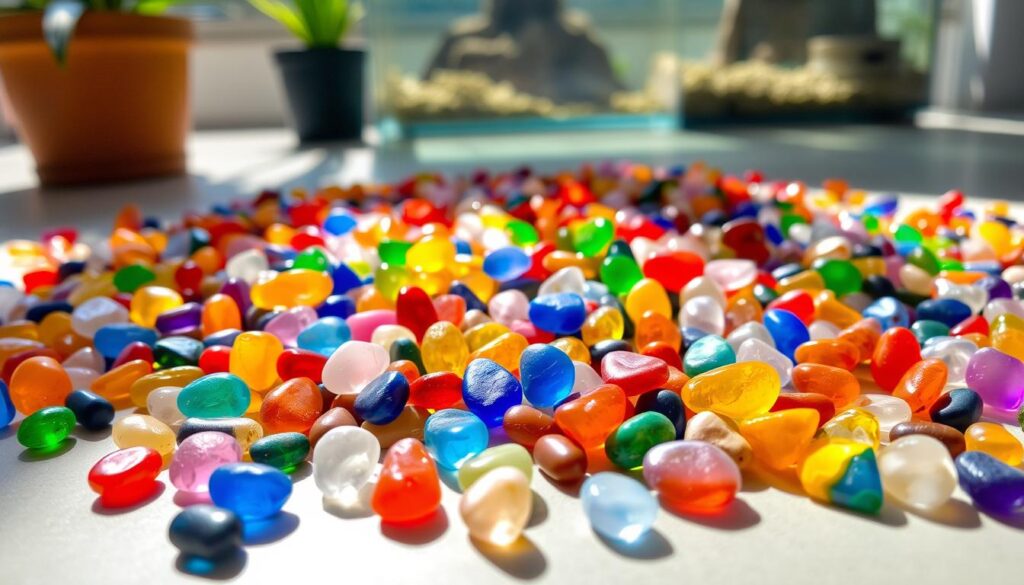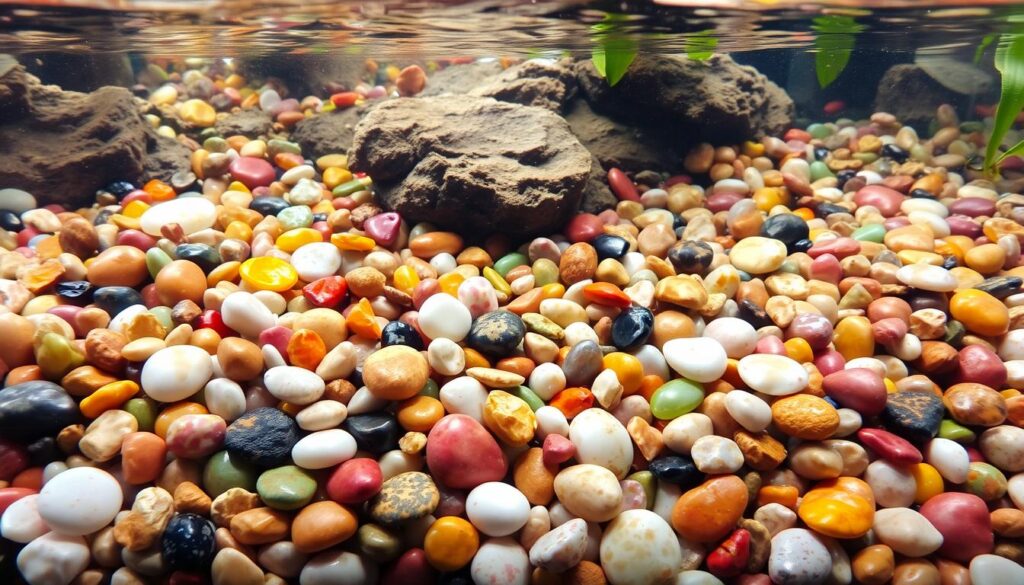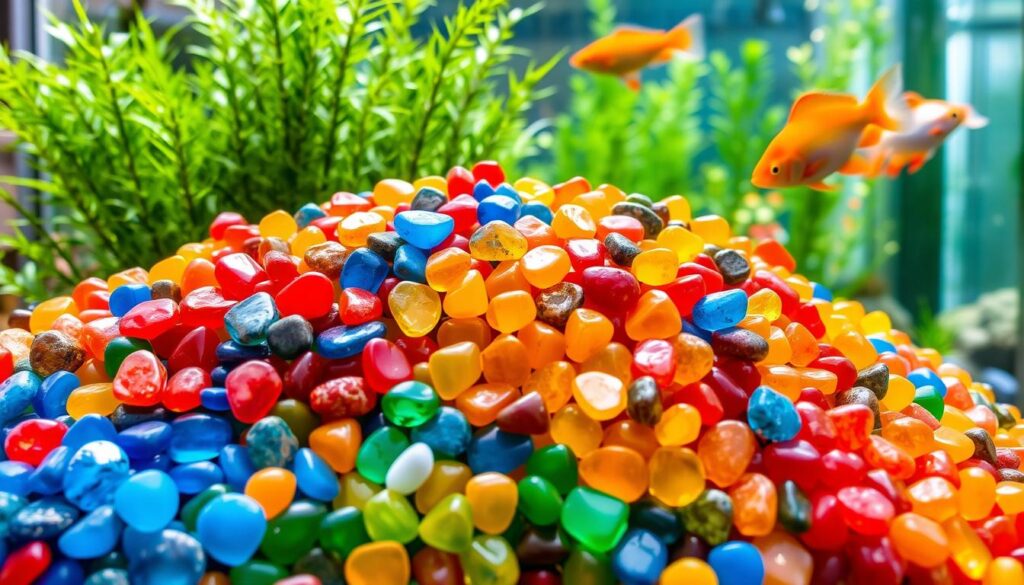Make your indoor and outdoor spaces more beautiful with RiverRocks’ stunning multi-color pebbles. These decorative stones are perfect for making your plant pots and aquarium decor stand out. They are great for both garden lovers and aquarium fans, adding a new look to your favorite items.
Our pebbles are made with care, offering a wide range of colors, shapes, and sizes. You can use them to create designs that match your style. Whether you prefer natural or artificially colored pebbles, our collection will bring elegance and interest to any space.

Key Takeaways
- Discover RiverRocks’ diverse collection of decorative pebbles for plant pots and aquarium decor
- Explore the versatility of multi-color pebbles in enhancing indoor and outdoor spaces
- Learn how to create stunning visual effects with a variety of pebble types and sizes
- Elevate the aesthetics of your gardens, terrariums, and aquariums with these versatile decorative stones
- Discover the benefits of using RiverRocks’ high-quality pebbles for your plant and aquarium needs
Understanding Decorative Pebbles: Types and Applications
Decorative pebbles come in many shapes, sizes, and materials. Each type has its own look and uses for your plant pots, aquarium, or home decor. Whether you like the natural look of river rocks or the uniform look of artificial pebbles, knowing the differences can help you choose.
Natural vs. Artificial Pebbles
Natural decorative pebbles come from nature, like streams or beaches. They have a natural, irregular look that adds a rustic feel to your decor. Artificial pebbles, made from various materials, look more uniform and consistent.
Size Classifications and Uses
Decorative pebbles vary in size, from small gravel to large river rocks. Small pebbles, 1/4 to 1/2 inch, are great for plant pots and aquariums. They help with drainage and look good. Larger pebbles, 1 to 3 inches, are used in landscaping for paths or dry creek beds.
Common Materials and Compositions
| Material | Characteristics | Common Uses |
|---|---|---|
| Quartz | Durable, shiny, and available in a variety of colors | Plant pots, aquariums, landscaping |
| Limestone | Soft, neutral-toned, and suitable for pH-sensitive environments | Aquariums, plant pots for acid-loving plants |
| Lava Rock | Porous, lightweight, and ideal for improving drainage | Plant pots, soil amendments, aquarium filtration |
| Ceramic | Uniform in appearance, durable, and available in a wide range of colors | Plant pots, decorative accents |
Knowing about the different types of decorative pebbles helps you choose the right one for your needs and style.
Benefits of Using Decorative Pebbles in Plant Pots
Decorative pebbles in plant pots bring many benefits. They make your indoor or outdoor spaces look better. They also help your plants stay healthy and strong. Let’s look at the main advantages of using decorative pebbles.
Improved Soil Moisture Retention
Pebbles help keep the soil moist. They stop water from evaporating too fast. This is great for plants that need steady moisture. It means you don’t have to water as often, making plant care easier.
Effective Weed Prevention
Decorative pebbles on the soil surface stop weeds from growing. This makes your plant pots look better and saves you from weeding. It’s a big time and effort saver for keeping your plants weed-free.
Enhanced Drainage Improvement
Pebbles also help with drainage. They let water flow through, preventing waterlogging. This ensures your plants get the right moisture, helping their roots grow well.
Aesthetic Appeal
Decorative pebbles add beauty to your plant pots. They come in many colors, sizes, and textures. You can match them with your plants or create a stunning design. They make your space look more elegant and interesting.
Using decorative pebbles in your plant pots has many benefits. They improve soil moisture, prevent weeds, enhance drainage, and add beauty. These pebbles are a great way to make your plants look and feel their best.
| Benefit | Description |
|---|---|
| Soil Moisture Retention | Pebbles act as a natural mulch, helping to retain moisture in the soil and preventing rapid evaporation. |
| Weed Prevention | The pebble layer creates a physical barrier that discourages the growth of weeds. |
| Drainage Improvement | Decorative pebbles allow excess water to flow through, preventing waterlogging and promoting optimal root health. |
| Aesthetic Appeal | Decorative pebbles can add a touch of elegance and visual interest to your plant pots, with a wide range of colors, sizes, and textures available. |
Multi-Color Pebbles for Decoration – Pebbles for Plants Pots, Fish Tank Aquarium
Adding colorful pebbles to your plant pots and aquariums can make them look amazing. By picking and arranging these natural stones, you can make stunning displays. These displays will catch the eye and make your spaces look better.
Color Selection Guide
There are so many colors to choose from. Pebbles range from bright reds and blues to calm browns and greens. Pick pebbles that match or contrast with your pots or aquarium’s colors.
Mixing and Matching Techniques
- Blend complementary colors for a harmonious look, such as pairing cool-toned blues with warm-hued oranges.
- Create a striking contrast by mixing light and dark pebbles, or opt for a monochromatic palette for a sleek, minimalist aesthetic.
- Incorporate a variety of shapes and sizes to add visual interest and depth to your design.
Creating Visual Interest with Layers
Layering pebbles can make your plant pots or aquariums stand out. Start with big pebbles, then add smaller ones in different colors. This makes your display look great and keeps the pebbles in place.
Using multi-color pebbles can turn your plant pots and aquariums into stunning pieces. Try mixing colors, textures, and layers to match your style. This will make your spaces even more beautiful.
Essential Tips for Aquarium Pebble Installation
Choosing the right aquarium substrate is key to a great-looking and healthy aquarium. Decorative pebble placement is vital for a beautiful fish tank setup that also keeps the water clean. Here are some expert tips for a successful pebble installation.
Preparing the Substrate
Start by cleaning the tank bottom well before adding pebbles. Remove all debris or residue. This step ensures a clean base for your pebbles, helping with water flow and fish health.
Pebble Placement Techniques
Think about the depth and spread of the pebbles. Aim for 1-2 inches deep to support plants and fish movement. Try different patterns and placements to get the look you want, like slopes or focal points.
Maintaining Water Quality
The aquarium substrate is key to keeping the water clean. Choose pebbles that won’t harm the water. Regular cleaning and water changes are also important for a healthy tank.

“Proper pebble placement and substrate preparation can truly elevate the beauty and functionality of your aquarium.”
By following these tips, you can make a beautiful and balanced aquarium. It will show off the beauty of decorative pebbles and keep your fish healthy.
Maintaining and Cleaning Decorative Pebbles
Keeping your decorative pebbles clean and beautiful is key. It helps your plant pots and aquarium look great. A regular cleaning routine and deep cleaning methods can prevent algae growth.
Weekly Maintenance Schedule
For a clean look, clean your pebbles weekly. Use a soft-bristled brush to remove dust and debris. Also, rinse them with clean water to keep them free of contaminants.
Deep Cleaning Methods
Sometimes, your pebbles need a deeper clean. This is called pebble cleaning. Start by taking the pebbles out and soaking them in warm water with mild detergent. Then, scrub them gently with a soft brush. Rinse well and let them dry before putting them back.
Preventing Algae Growth
- Keep water parameters right: Check pH, temperature, and light to stop algae.
- Change water often: Regular water changes remove nutrients that algae love.
- Use algae prevention tools: Special products can stop algae from growing on your pebbles.
By following these steps, your decorative pebbles will stay clean and enhance your plant pots and aquarium’s look.
Safety Considerations for Plant and Aquatic Life
Decorating your plant pots or aquarium needs careful thought. You must choose non-toxic pebbles, plant-safe materials, and fish-friendly decorations to keep your plants and fish safe. This ensures a healthy, thriving environment for them.
Using decorative pebbles can be risky if they’re not safe. Look for chemical-free stones that won’t harm your plants or water. Stay away from materials with harmful chemicals or dyes that could upset your ecosystem’s balance.
- Choose pebbles from natural, plant-safe materials like river rocks, quartz, or polished stones.
- Avoid pebbles treated with paints, sealants, or artificial coatings.
- Make sure the pebbles are fish-friendly decorations that won’t harm your fish.
By picking the right decorative pebbles, you can make a beautiful, non-toxic space. This supports the health of your plants and fish. A bit of research ensures a thriving, sustainable ecosystem.

Creative Design Ideas and Inspiration
Discover the magic of pebble art with these exciting design ideas. From simple to themed, and seasonal, explore how decorative pebbles can turn your plant pots and aquariums into stunning art. Let your creativity flow and see the endless possibilities.
Minimalist Arrangements
Simple designs can be incredibly beautiful. Use a single color of pebbles in a neat pattern for a modern look. Or mix a few colors for a softer, more harmonious effect. Let each pebble stand out and become the main attraction.
Themed Designs
Show off your creativity with themed pebble displays. Create an underwater scene with themed aquascapes using different pebbles to look like a riverbed. For creative landscaping, make patterns that look like streams or mountains. The world of pebble art is full of endless ideas.
Seasonal Variations
Change up your decor with the seasons using seasonal decor. Welcome spring with bright, pastel pebbles. Summer calls for earthy tones. Autumn brings rich, deep colors. And winter is perfect for whites and silvers for a calm look.
“Decorative pebbles are the perfect canvas for unleashing your creative vision. With a little imagination, you can transform any space into a stunning, one-of-a-kind masterpiece.”
Conclusion
We’ve looked into the world of decorative pebbles and their uses in plant pots and aquariums. These elements make spaces look better and offer real benefits. They help with soil drainage and create a natural home for fish.
Looking to beautify your indoor garden or make an underwater scene? RiverRocks offers a wide range of pebbles. You can choose from calm colors to bright, bold ones. These pebbles can turn any area into a beautiful oasis.
As you work on your plant pots and aquariums, keep in mind the benefits of RiverRocks pebbles. They’re durable, versatile, and boost the look of your space. They’re essential for creating a natural paradise, whether it’s on land or in water.
FAQ
What are the different types of decorative pebbles available?
Decorative pebbles come in two main types: natural and artificial. Natural pebbles are found in rivers, beaches, or quarries. Artificial pebbles are made by humans, often from resin or other materials.
What are the common materials used in decorative pebbles?
Pebbles are usually made from natural stuff like river rocks, quartz, slate, and marble. Artificial ones might be resin, ceramic, or synthetic.
How can decorative pebbles benefit plant pots?
Pebbles help plant pots in many ways. They keep the soil moist, stop weeds, improve drainage, and look good. They help plants grow well and make the pot look nicer.
What considerations should be made when using decorative pebbles in aquariums?
For aquariums, pick pebbles that are safe for fish and won’t harm them. Make sure they’re clean and installed right to keep the water good for fish.
How can I create visually appealing designs with multi-color pebbles?
To make cool designs with multi-color pebbles, play with colors, mix them, and layer them. This adds depth and interest to your pots or aquariums.
How can I maintain and clean decorative pebbles?
Keep pebbles clean by doing a weekly check and sometimes a deep clean. This stops algae and keeps them looking great.
What safety considerations should I keep in mind when using decorative pebbles?
Always choose safe, plant-friendly, and fish-safe pebbles. This keeps your plants and fish healthy and safe.




 No products in the cart.
No products in the cart.